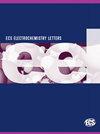锂离子电池用非晶硅纳米管薄膜负极的容量和耐久性
引用次数: 14
摘要
在这篇文章中,我们报道了一个负载为0.6 mg的硅纳米管薄膜电极,其初始放电容量为4766 mAh g - 1,并在100 mA g - 1速率下循环20次后保持约3400 mAh g - 1。采用硅沉积的方法制备了厚度在10 ~ 28微米之间的硅纳米管薄膜样品,并将氧化锌芯去除。所开发的硅纳米结构具有两端开放的管状几何形状。具有薄壁的纳米管在锂化过程中可以适应较大的体积变化,并表现出稳定的容量保持。氢化纳米晶硅(nc-Si:H)的存在对锂离子电池应用中的硅纳米管薄膜性能至关重要。©作者2015。由ECS出版。这是一篇在知识共享署名4.0许可(CC BY, http://creativecommons.org/licenses/by/4.0/)的条款下发布的开放获取文章,该许可允许在任何情况下不受限制地重复使用该作品本文章由计算机程序翻译,如有差异,请以英文原文为准。
The Capacity and Durability of Amorphous Silicon Nanotube Thin Film Anode for Lithium Ion Battery Applications
In this communication, we report that a silicon nanotube thin film electrode with 0.6 mg loading exhibited an initial discharge capacity of 4766 mAh g −1 and retained about 3400 mAh g −1 after 20 cycles at 100 mA g −1 rate. The silicon nanotube thin film samples with thicknesses ranging from 10‐28 microns were prepared using silicon deposition on bulk produced zinc oxide nanowire films and subsequent removal of zinc oxide cores. The developed silicon nanostructures exhibit tubular geometry with both open ends. The nanotubes with thin walls are shown to accommodate large volume changes with lithiation and exhibit stable capacity retention. The presence of hydrogenated nanocrystalline silicon (nc-Si:H) is shown to be essential for the silicon nanotube thin film performance for lithium ion battery applications. © The Author(s) 2015. Published by ECS. This is an open access article distributed under the terms of the Creative Commons Attribution 4.0 License (CC BY, http://creativecommons.org/licenses/by/4.0/), which permits unrestricted reuse of the work in any
求助全文
通过发布文献求助,成功后即可免费获取论文全文。
去求助
来源期刊

ECS Electrochemistry Letters
ELECTROCHEMISTRY-MATERIALS SCIENCE, MULTIDISCIPLINARY
自引率
0.00%
发文量
0
 求助内容:
求助内容: 应助结果提醒方式:
应助结果提醒方式:


